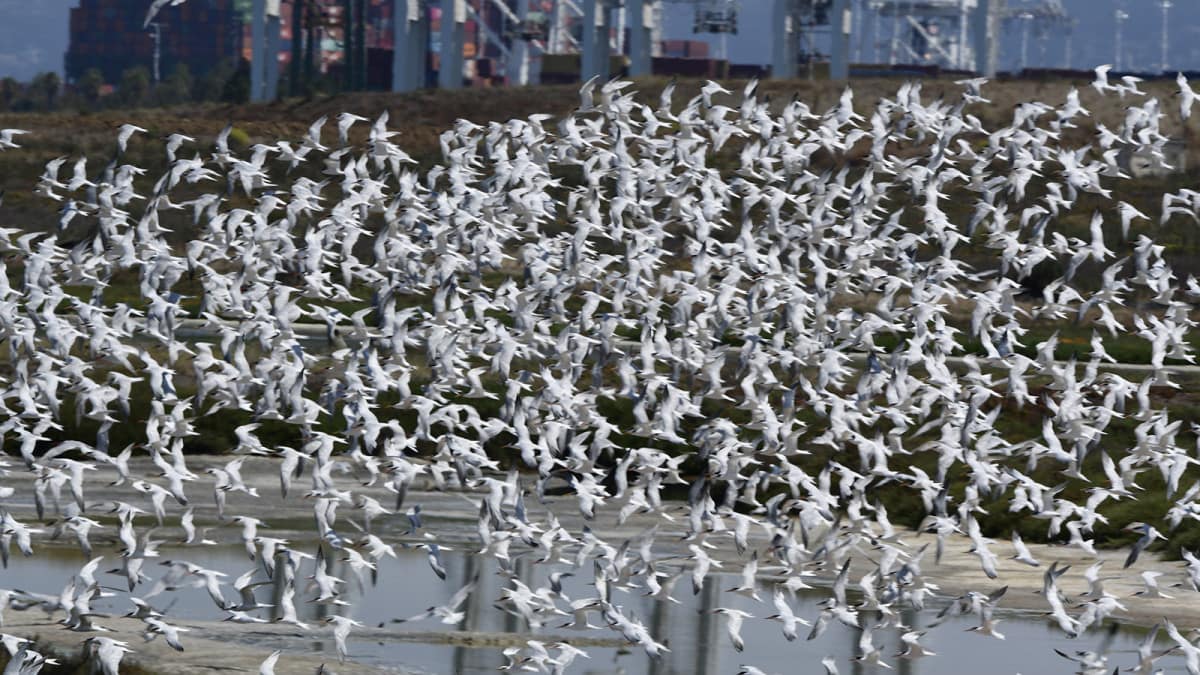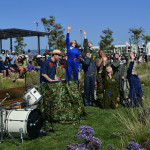Caspian Terns and Elegant Terns join struggling Least Terns
Naval Air Station – Alameda gained notoriety as a refuge for the endangered California Least Tern when the base closed in 1997. Over 500 acres were dedicated to protecting the terns’ adopted nesting site next to a runway formerly used by jet aircraft.
This unlikely bird habitat for the Least Terns some 400 miles north of their historic breeding grounds along the southern California coast offered the birds something they had lost, which drove them to the brink of extinction – nesting sites free of human disturbance near a source of small fish to feed their chicks.
Two new species nesting at Alameda Point
Surprisingly, two other species have recently begun nesting in the vicinity. Elegant and Caspian Terns seem to be thriving there, while the endangered Least Terns are struggling.

Elegant Terns, whose historic breeding grounds are also along the southern California coast and in Mexico, have started nesting at Alameda Point on a beach in wetland not far from where the Least Terns nest. When the Elegant Terns were first seen nesting at Alameda Point in 2019, it was the first documented instance of this species nesting this far north.
More than 90 percent of all Elegant Terns nest in a single colony on Isla Rasa in the Gulf of California (Sea of Cortez), Mexico, according to Cornell University’s All About Birds website. The remaining 10 percent nest on the nearby island of Isla Montague, on a few isolated beaches in southern California and, as of 2019, at Alameda Point.

The Elegant Terns were attracted to the tiny wetland beach where another species, the Caspian Tern, had taken to nesting immediately after the Navy had finished its wetland expansion and environmental remediation in 2014. In the last two years, the combined annual population of Elegant and Caspian Terns nesting in the secluded wetland has been over 1,500.
Least Terns success rate dropping fast
Stewardship of the three species at Alameda Point over the last two years is recounted in the 2020 and 2021 annual reports prepared by U.S. Fish and Wildlife Service biologist Susan Euing. While 2020 was an average good year for Least Tern breeding at Alameda Point, 2021 was not.

In 2021, the success rate dropped almost in half per breeding pair from the prior year. Peregrine Falcons accounted for the loss of dozens of chicks, fledglings and adults, while Common Ravens were responsible for the loss of dozens of eggs.
This low success rate was not simply the fault of predators. Euing reported that 118 eggs failed. Plus, 100 chicks, four fledglings, and two adults died on site. Out of the 118 failed eggs, 40 had been abandoned, 71 were non-viable and seven died while hatching.
“Out of the 501 hatches, nearly 20% died, compared to 5% in 2020,” Euing states. “Seventy nine of the 100 chicks were under 3 days old, 20 were between 3-13 days old and fully feathered.”
Euing surmises that reduced availability of small fish or frequency of delivery to chicks might help explain the high percentage of dead chicks in 2021. When adults bring fish to the tiny chicks, they have to gulp them down whole. If the fish are too large, the chick is out of luck.

The plunging success rate for the Least Terns in 2021 was not unique to Alameda Point. Their reproductive success statewide has steadily declined by over half from its peak in 2009 when nesting pairs were estimated between 7,100 and 7,350, producing as many as 2,000 fledglings.
“This population has since seen a dramatic downward trend, culminating in a 2021 estimation of nesting pairs in the range of 3,500 to 4,300, producing as few as 800 fledglings,” writes Tyler Faurot (“California least tern’s survival in Mission Bay depends on volunteers,” Pacific Beach Monthly, April 6, 2022).
The fledgling-to-breeding-pair ratio is one of the criteria established by the U.S. Fish and Wildlife Service to evaluate whether the species has reached the goals for removing it from the Endangered Species list. The goal is to average one fledgling per breeding pair, but it is rarely achieved anywhere in California. The Alameda Point colony, one of the most successful colonies in the state, has hit this target only four times in the last 20 years.
VA steps in
When the U.S. Department of Veterans Affairs (VA) took ownership of 624 acres of the old airfield in 2014, only 120 acres of which they need for their facilities, they took over responsibility for managing the Least Terns. The VA retained biologist Euing to manage the Least Terns. Even though the Caspian Terns and Elegant Terns are not endangered species that the VA is required to manage, Euing has convinced the VA to pay for removing vegetation that had begun overtaking the small beach where the these larger cousins of the Least Terns nest.
Nesting of the Least Terns on the Navy airfield was first documented in 1976.
See the terns with EBRPD bus tours
After a two-year hiatus due to COVID restrictions, East Bay Regional Park District‘s annual Return of the Terns bus tours to view the Least Terns at their nesting site will resume on June 25th. Call 888-EB-PARKS to sign up. Three tours leave from the Crab Cove Visitor Center, at 11:00 a.m., 12:15 p.m., and 1:30 p.m. Registration is required.
Contributing writer Richard Bangert posts stories and photos about environmental issues on his blog Alameda Point Environmental Report, https://alamedapointenviro.com/.



